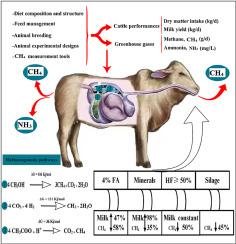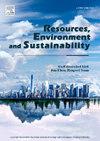全球奶牛生产性能和温室气体减排的饲养策略荟萃分析
IF 7.8
Q1 ENVIRONMENTAL SCIENCES
引用次数: 0
摘要
关于牛饲养策略对温室气体排放影响的研究是零散的,无法提供全球比较的饲养管理做法,这些做法可以在大幅减少甲烷(CH4)和氨(NH3)排放的同时实现最佳生产。本研究解释了饲粮组成和结构、饲料管理、育种、动物实验设计和CH4测量工具对肠道CH4、NH3缓解和奶牛产奶性能的影响。我们从最初筛选的4394篇论文中对80种治疗方法的效果进行了荟萃分析,并保留了分布在四大洲15个国家的31篇文章。饲料添加剂类型中的矿物质提高产奶量最多(90%),同时减少甲烷产量33%。饲料添加剂添加量在1 ~ 4%之间也有助于提高产奶量47%,减少甲烷58%。同时,3-硝基氧丙醇(3-NOP)饲料添加剂对健康安全的影响仍存在争议。虽然部分混合日粮系统对产奶量贡献很大(102%),但它对减少CH4的贡献不如完全混合日粮系统(39%)。采用GreenFeed(80%)和旋转实验设计(37%)记录的CH4减少水平最高。荷斯坦牛品种产量更高,产奶量增加46%,CH4减少34%。草料使NH3增加5%,而作物饲料使NH3减少21%。农业可以通过涉及多个部门的协调一致的全球努力,有效地减少排放,为实现气候中和目标作出贡献。本文章由计算机程序翻译,如有差异,请以英文原文为准。

A meta-analysis of feeding strategies for dairy cattle performance and greenhouse gas mitigation across the world
Studies on the effects of cattle feeding strategies on greenhouse gas emissions are fragmented and cannot provide a global comparison of the feeding management practices that lead to optimal production while substantially reducing methane (CH4) and ammonia (NH3) emissions. The present study explains variability in enteric CH4, NH3 mitigations and cattle milk performance due to several diet composition and structure, feed management, breeding, animal experimental designs and CH4 measurement tools. Effects from 80 treatments were meta-analyzed from an initial 4394 screened papers and we retained 31 articles distributed across 15 countries on four continents. Minerals in feed additive types increased milk yield the most (90 %) and, concomitantly, reduced CH4 production by 33 %. Feed additive dosage ranging between 1 and 4 % also contributed to increasing milk yield by 47 % while reducing CH4 by 58 %. Meanwhile the impact of 3-nitrooxypropanol (3-NOP) feed additive on health safety is still controversial. Although a partial mixed ration system highly contributed to milk yield (102 %), it did not contribute to CH4 reduction as much as a total mixed ration system (39 %). The highest CH4 reduction levels were recorded with GreenFeed (80 %) and a rotating experimental design (37 %). The Holstein cattle breed was more productive with an increase of 46 % of milk production while reducing CH4 by 34 %. Grass forage increased NH3 by 5 % while crop forage reduced it by 21 %. Agriculture can effectively reduce its emissions and contribute to climate-neutral goals as part of a coordinated, global effort involving multiple sectors.
求助全文
通过发布文献求助,成功后即可免费获取论文全文。
去求助
来源期刊

Resources Environment and Sustainability
Environmental Science-Environmental Science (miscellaneous)
CiteScore
15.10
自引率
0.00%
发文量
41
审稿时长
33 days
 求助内容:
求助内容: 应助结果提醒方式:
应助结果提醒方式:


